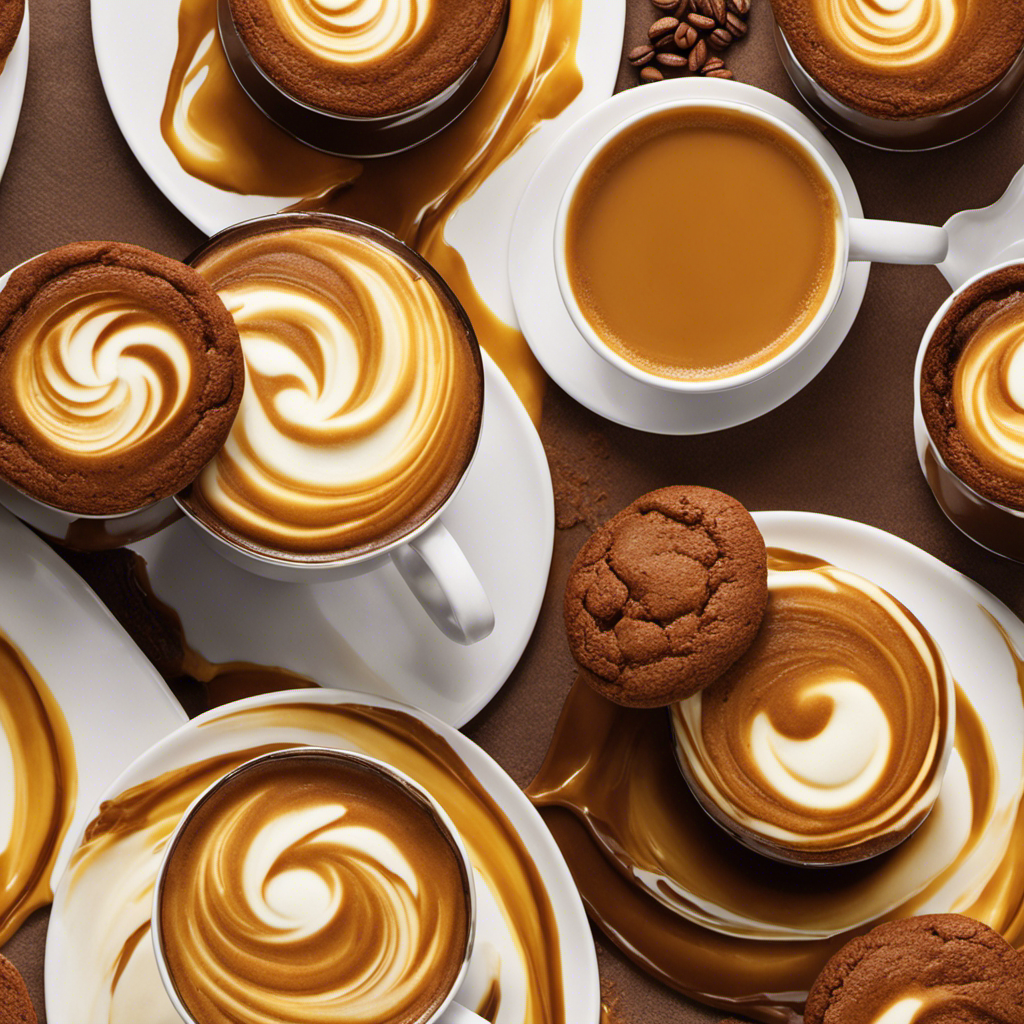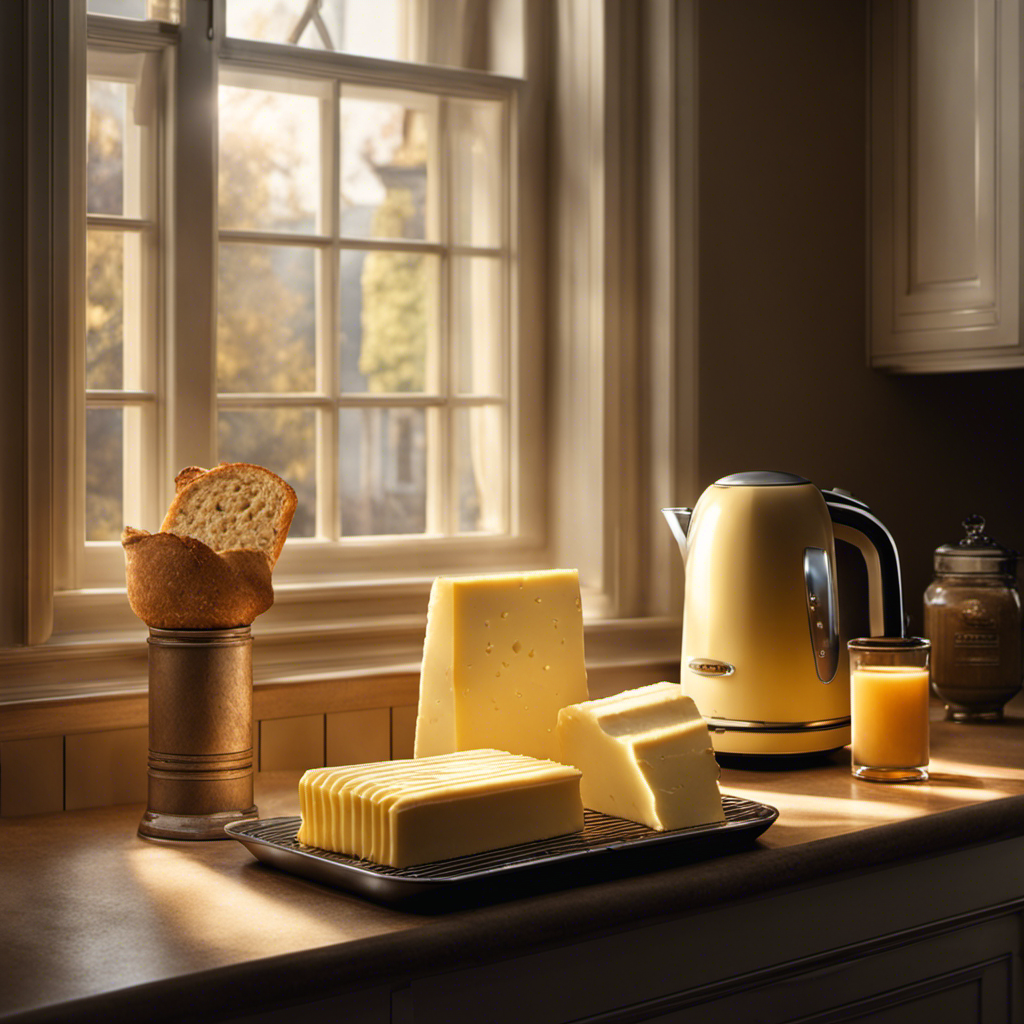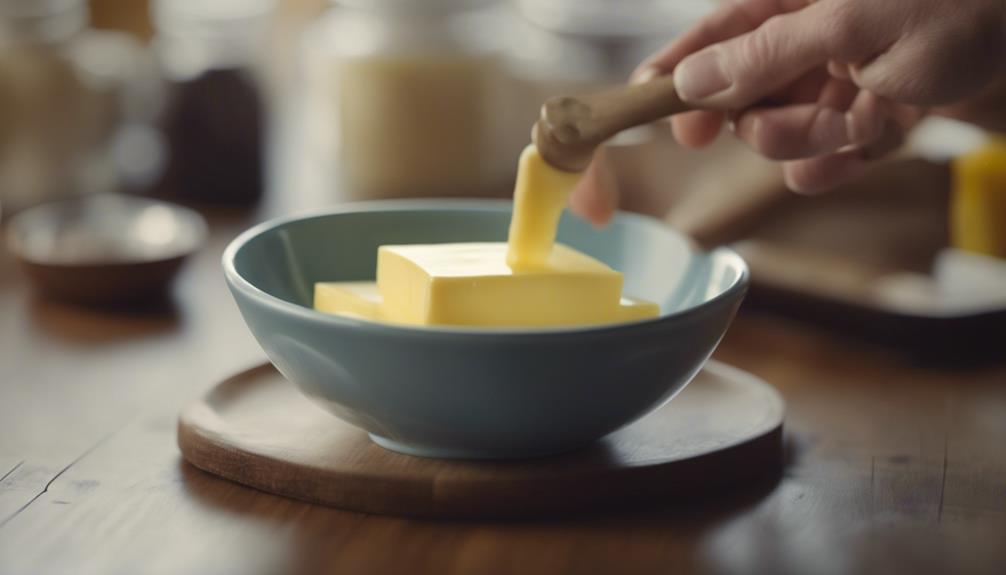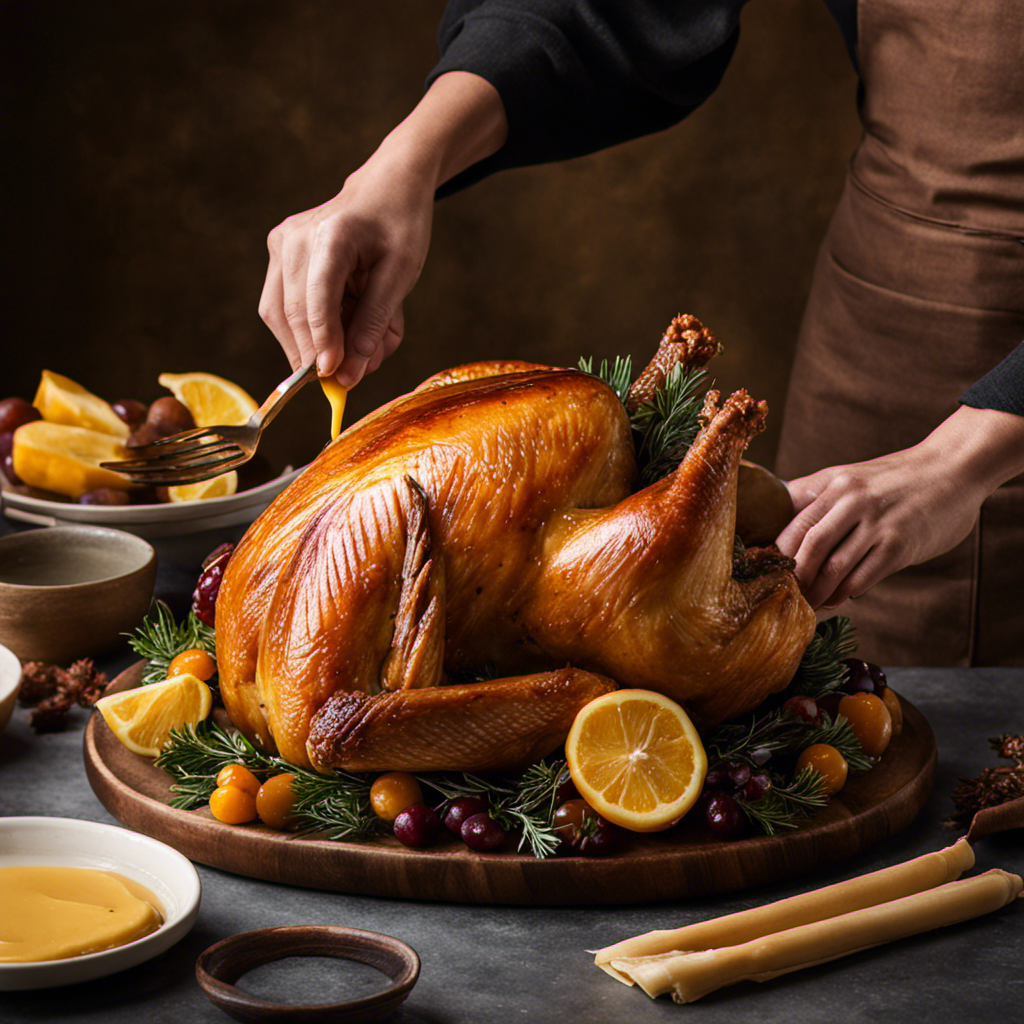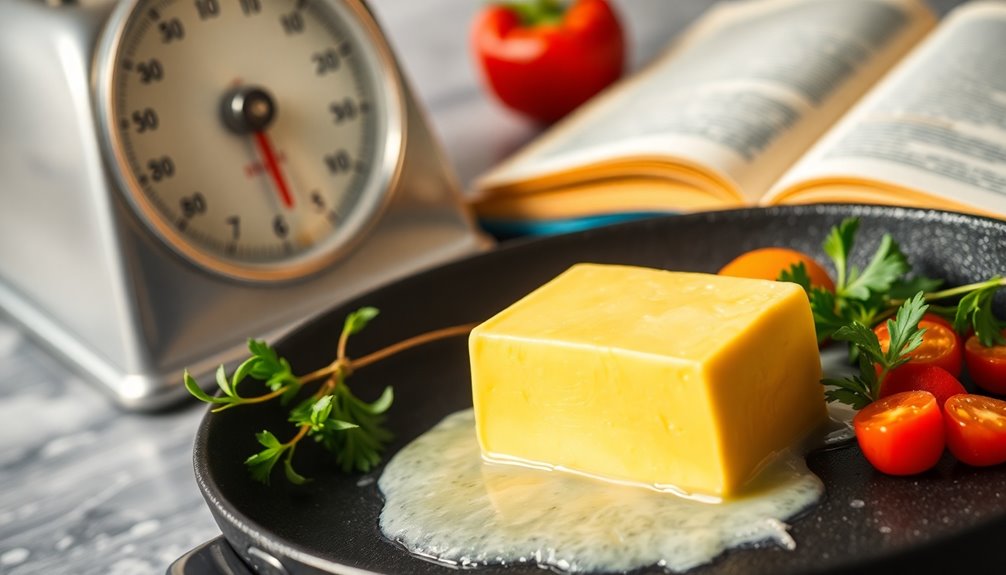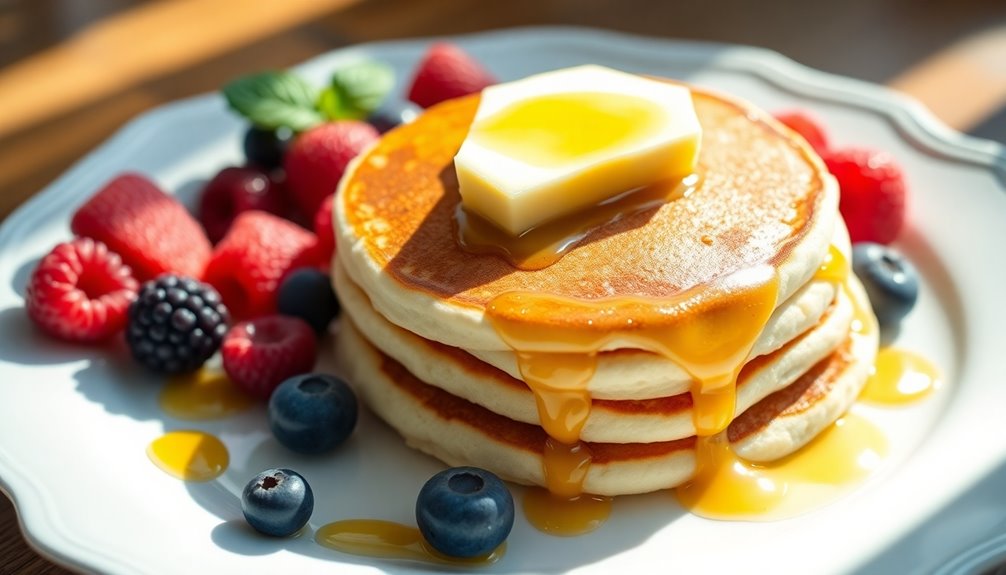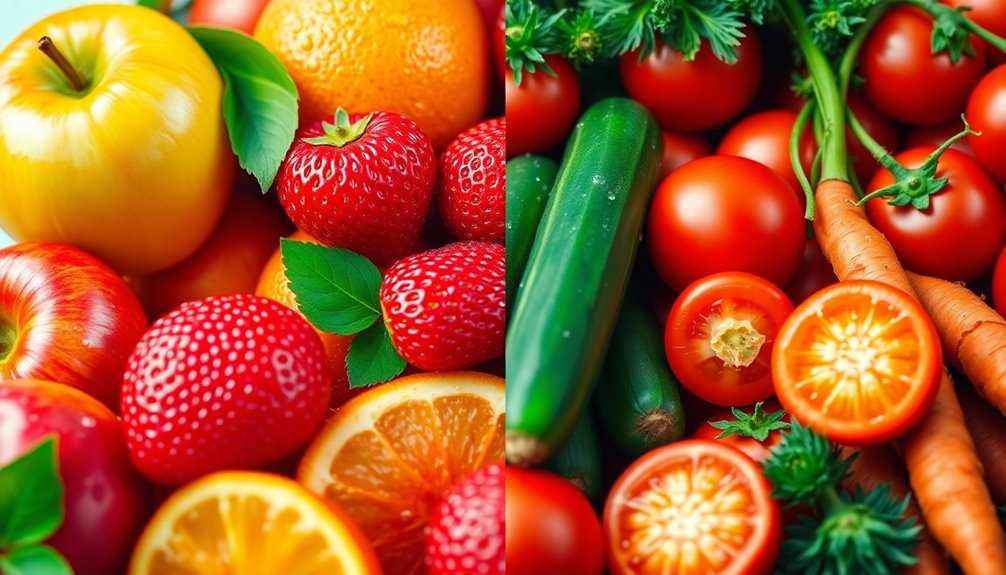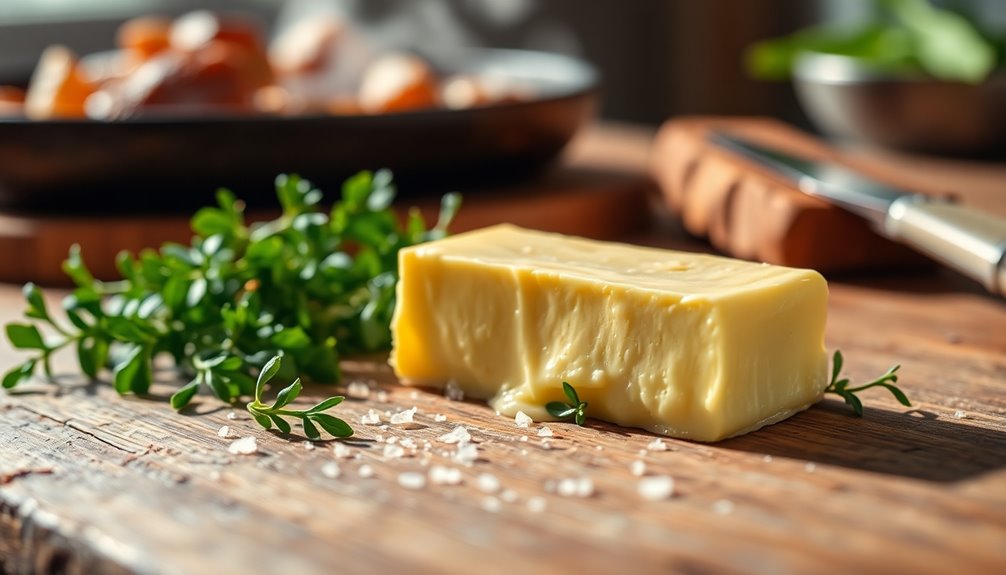I have always loved coffee, but recently I came across a new trend that has completely changed my morning routine: adding butter to my coffee.
At first, I was skeptical, but after trying it for myself, I was amazed by the delicious and creamy flavor it added to my cup of joe.
Intrigued by this unique combination, I delved into the science behind it and discovered some surprising benefits.
In this article, I’ll share with you the reasons why adding butter to your coffee might just be the secret to your best morning brew yet.
Key Takeaways
- Butter adds a creamy and rich texture to coffee.
- Consuming buttered coffee in moderation can provide health benefits, such as increased satiety and sustained energy.
- Excessive consumption of buttered coffee can lead to health risks, such as increased cholesterol levels.
- It is advisable to consult with a healthcare professional before making significant changes to your diet.
The Benefits of Adding Butter to Your Coffee
You might be wondering why adding butter to your coffee can be beneficial. Well, let me tell you that it’s not just a trend, but there are actually some science-backed reasons behind it.
Firstly, adding butter to your coffee can enhance the flavor profile. The creamy and rich texture of butter adds a smoothness to your coffee, making it more enjoyable to drink.
Secondly, butter can help increase the bioavailability of certain nutrients in coffee, such as antioxidants. The healthy fats in butter can also provide sustained energy and keep you feeling full for longer.
Lastly, when it comes to brewing methods, using a blender to mix the butter into your coffee can create a frothy and indulgent beverage.
How Butter Can Enhance the Flavor of Your Morning Brew
I’ve always been a fan of coffee, but recently I discovered a new way to enhance its flavor and richness.
It’s called Butter’s Creamy Coffee Infusion, and it’s a game-changer. By adding a pat of butter to my morning brew, I’ve noticed a smoother and creamier texture, as well as a more robust and satisfying taste.
Butter’s Creamy Coffee Infusion
Butter’s creamy infusion adds a unique richness to coffee. It may seem unusual, but adding butter to your morning brew can actually enhance the flavor and create a velvety smooth texture. Here are four variations of butter coffee that you can try for a delightful flavor experimentation:
-
Bulletproof Coffee: This popular recipe combines coffee, grass-fed butter, and MCT oil for a creamy and energy-boosting drink.
-
Vanilla Butter Coffee: Add a dash of vanilla extract to your coffee along with a pat of butter for a subtly sweet and aromatic twist.
-
Cinnamon Butter Coffee: Sprinkle some cinnamon into your coffee and stir in a spoonful of butter for a warm and comforting flavor.
-
Chocolate Butter Coffee: Mix in some cocoa powder or chocolate syrup with butter for a rich and indulgent mocha-like experience.
These variations allow you to explore different flavors and find the perfect butter coffee combination that suits your taste buds. So go ahead, give butter coffee a try and discover a new way to enjoy your morning cup of joe.
Enhancing Coffee’s Richness
To enhance the richness of your morning brew, consider adding a dash of cream or a sprinkle of cocoa powder. These simple additions can take your coffee from ordinary to extraordinary.
If you’re looking to elevate your coffee experience even further, you might want to try some alternative coffee additives, such as butter. Butter coffee recipes have gained popularity in recent years, thanks to their unique flavor and potential health benefits. By blending a tablespoon of unsalted butter into your coffee, you can create a creamy and frothy concoction that is sure to satisfy your taste buds.
The butter adds a smooth texture and a subtle richness to the coffee, making it a delightful treat. So next time you’re craving a little something extra in your morning cup of joe, give butter coffee a try. You might just discover a new favorite way to enjoy your daily dose of caffeine.
The Science Behind Butter’s Effect on Coffee
When it comes to adding butter to your morning coffee, there are several key points to consider.
Firstly, how does it enhance or alter the flavor of your brew?
Secondly, what are the potential health benefits or risks associated with this practice?
And finally, is there scientific evidence to support the claims surrounding butter in coffee?
In this discussion, we will delve into these questions to provide you with a comprehensive understanding of the science behind butter’s effect on coffee.
Flavor Enhancement or Alteration
Adding butter to coffee can definitely change its flavor profile and enhance the overall taste experience. Here are four ways in which butter can enhance the flavor of coffee:
-
Creaminess: Butter adds a rich and creamy texture to coffee, making it feel indulgent and satisfying.
-
Smoothness: Butter can help smooth out any bitter or harsh flavors in coffee, creating a more balanced and enjoyable taste.
-
Nutty notes: Butter has a natural nutty flavor that can complement the flavors of coffee, adding depth and complexity to the overall taste.
-
Sweetness: Butter can enhance the natural sweetness of coffee, reducing the need for additional sugar or sweeteners.
Ultimately, whether adding butter to coffee enhances or alters the flavor will depend on personal taste preference. Some may enjoy the added richness and complexity, while others may prefer the traditional taste of black coffee. It’s worth experimenting to find out what works best for you.
Health Benefits or Risks
Contrary to popular belief, there are actually health benefits associated with consuming buttered coffee in moderation. While butter may seem like an unhealthy addition to your morning cup of joe, it can actually provide some surprising advantages.
Firstly, the healthy fats found in butter can help increase satiety, keeping you feeling fuller for longer and potentially aiding in weight management. Additionally, buttered coffee can provide a sustained release of energy throughout the day, thanks to the combination of caffeine and fat.
However, it’s important to note that consuming too much buttered coffee can lead to health risks, such as increased cholesterol levels, so moderation is key.
Now, let’s delve deeper into the scientific evidence supporting these claims.
Scientific Evidence Supporting Claims?
To better understand the health benefits or risks associated with buttered coffee, you should explore the scientific evidence supporting these claims. Here are four key points to consider:
-
Limited scientific evidence: While there are anecdotal reports and personal testimonials touting the benefits of buttered coffee, there is a lack of robust scientific studies supporting these claims. More research is needed to determine the true effects on health.
-
High in saturated fat: Buttered coffee is made by adding butter or ghee to your coffee, which increases the saturated fat content. Consuming excessive amounts of saturated fat can raise cholesterol levels and increase the risk of heart disease.
-
Calorie-dense: Buttered coffee is also high in calories due to the added fat. If you’re watching your calorie intake or trying to lose weight, it’s important to consider the extra calories from buttered coffee.
-
Individual variation: It’s important to remember that everyone’s body is different, and what works for one person may not work for another. It’s always best to consult with a healthcare professional before making any significant changes to your diet.
While buttered coffee may be enjoyed by some, it’s crucial to consider the scientific evidence and potential health risks before incorporating it into your daily routine.
Exploring the Origins of Butter in Coffee
Butter in coffee, also known as bulletproof coffee, has gained popularity in recent years as a result of the ketogenic diet trend. This unique beverage has its origins in the traditional Tibetan drink called "Yak Butter Tea." In the high-altitude regions of Tibet, where the climate is harsh and energy-dense foods are scarce, butter tea has been a staple for centuries. The combination of yak butter and tea provided a rich source of calories and essential nutrients to sustain the body in extreme conditions. The cultural significance of butter in coffee has expanded beyond Tibet, with the bulletproof coffee trend gaining momentum around the world. People are drawn to its potential health benefits, such as increased energy levels and improved mental focus. Additionally, the creamy texture and unique flavor add a delightful twist to the daily coffee routine.
| Origins | Cultural Significance | Health Benefits |
|---|---|---|
| Tibetan tradition | Expanding popularity | Increased energy |
| High-altitude regions | Bulletproof coffee trend | Improved focus |
| Calorie-dense source | Unique flavor | Potential weight loss support |
| Essential nutrients | Delightful twist to coffee | Promotes satiety |
| Centuries-old practice | Global appeal | Potential cognitive benefits |
Butter Coffee Vs. Traditional Coffee: a Taste Test
In a taste test comparing butter coffee and traditional coffee, participants rated the flavors and overall experience of each beverage. Here are the key findings from the taste test:
-
Flavor: Participants noted that butter coffee had a rich and creamy taste, with a hint of sweetness from the added butter. Traditional coffee, on the other hand, had a familiar and bolder flavor profile.
-
Texture: Butter coffee was described as smooth and velvety, thanks to the emulsified butter. Traditional coffee had a lighter texture, typical of regular brewed coffee.
-
Satiety: Many participants reported feeling more satisfied and full after consuming butter coffee, which can be attributed to the added fat content.
-
Health Implications: While butter coffee may offer a unique taste experience, it is important to consider the health implications of adding butter to coffee. Butter is high in saturated fats, which can increase cholesterol levels and potentially contribute to heart disease if consumed in excess.
Overall, the taste test revealed that butter coffee provides a distinct flavor and texture compared to traditional coffee, but it is essential to balance taste preferences with potential health risks.
Butter Coffee and Weight Loss: Separating Fact From Fiction
Separating fact from fiction, it’s important to understand the relationship between butter coffee and weight loss.
Butter coffee, also known as bulletproof coffee, is a beverage made by blending coffee with grass-fed butter and MCT oil. Some claim that consuming butter coffee can boost metabolism and aid in weight loss.
While there is limited scientific research specifically on butter coffee and weight loss, there are some potential mechanisms that could support these claims. For example, the medium-chain triglycerides (MCTs) in the butter and oil may increase satiety and promote fat burning. Additionally, the caffeine in coffee can temporarily boost metabolism.
However, it’s essential to remember that weight loss is a complex process that involves various factors, such as overall calorie intake and physical activity. Therefore, while butter coffee may have some potential benefits, it should not be seen as a magic solution for weight loss. It’s important to have a well-rounded approach that includes a balanced diet and regular exercise.
Moreover, it’s worth noting that butter coffee also has potential benefits for cognitive function due to the combination of caffeine and healthy fats. The caffeine can improve alertness and focus, while the fats provide a source of energy for the brain.
To summarize, while butter coffee may have some potential benefits for weight loss and cognitive function, it should be consumed as part of a balanced and healthy lifestyle.
How to Make the Perfect Cup of Butter Coffee at Home
When making the perfect cup of butter coffee at home, it’s important to choose high-quality ingredients. Here are four steps to help you achieve that perfect cup:
-
Start with a good quality coffee: Choose a coffee that you enjoy and that has a smooth flavor profile. This will be the base of your butter coffee.
-
Use grass-fed butter: Grass-fed butter is preferred for its higher nutrient content and richer flavor. It adds a creamy texture and a hint of sweetness to your coffee.
-
Consider alternatives: If you’re looking for butter coffee alternatives, you can try using ghee or coconut oil. These options provide similar benefits and flavors.
-
Blend it well: To achieve a creamy and frothy texture, blend your coffee with the butter or alternative using a blender or frother. This will help emulsify the fats and create a smooth consistency.
Butter coffee has gained popularity in coffee culture due to its unique flavor and potential health benefits. It adds richness and depth to your morning cup, making it a delicious and satisfying alternative to traditional coffee.
Frequently Asked Questions
Can I Use Any Type of Butter in My Coffee?
Yes, you can use any type of butter in your coffee. However, it is recommended to use unsalted, grass-fed butter for its rich flavor and potential health benefits, such as increased energy and improved cognitive function.
How Much Butter Should I Add to My Coffee?
Adding butter to coffee can enhance its flavor and provide various health benefits. However, there are alternative options like coconut oil or ghee. It ultimately depends on personal preference and dietary needs.
Does Adding Butter to Coffee Affect the Caffeine Content?
Adding butter to coffee can enhance the flavor and provide potential health benefits. It’s a delicious way to enjoy your morning cup of joe while potentially boosting energy and promoting satiety.
Can I Still Add Other Ingredients Like Sugar or Cream to My Butter Coffee?
Yes, you can still add other ingredients like sugar or cream to your butter coffee. Adding sweeteners can enhance the flavor, while cream can make it creamier. However, keep in mind the potential impact on the overall nutritional profile.
Is It Safe to Consume Butter Coffee Every Day?
It’s safe to consume butter coffee every day. Studies suggest potential health benefits, like increased energy and focus. Contrary to popular belief, regular consumption doesn’t significantly impact cholesterol levels. So go ahead and enjoy!
Conclusion
In conclusion, adding butter to your coffee can be a game-changer for your morning routine. Not only does it enhance the flavor of your brew, but it also offers numerous health benefits.
The science behind butter’s effect on coffee is fascinating, and the origins of this unique combination are worth exploring. And if you’re skeptical, I encourage you to try a taste test between butter coffee and traditional coffee – the difference might surprise you.
So why not give it a try and start your day with a perfect cup of butter coffee at home? It’s a simple yet effective way to elevate your coffee experience and potentially support your weight loss goals.
So go ahead, embrace the richness and creaminess of butter in your morning brew and savor the transformative power it brings.
